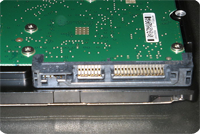Difference Between SATA and IDE Harddisk
 From the beginning of the computer era, the storage medium has been constantly evolving. From the floppy disks to the hard disk, their capacity has grown exponentially over the last few decades. But with the ever increasing capacities, new technologies should also be invented to cope up with the need to transfer large quantities of data as quickly as possible. This quest has lead to the transformation from Parallel ATA (also known as IDE) to Serial ATA.
From the beginning of the computer era, the storage medium has been constantly evolving. From the floppy disks to the hard disk, their capacity has grown exponentially over the last few decades. But with the ever increasing capacities, new technologies should also be invented to cope up with the need to transfer large quantities of data as quickly as possible. This quest has lead to the transformation from Parallel ATA (also known as IDE) to Serial ATA.
At first sight, you would not notice the difference between a PATA and a SATA disk. The main visual difference appears when you connect them to the motherboard. A PATA disk uses an 80 pin ribbon that is about 3-4 inches wide while the SATA disk uses a 7 pin cable that is less than an inch wide. This allowed for a cleaner cable arrangement inside the case.
The differences between the two don’t end there. SATA disks offer a huge difference in performance when transferring data. Even thhe earliest version of SATA had a maximum transfer rate of 150MB/sec which is already ahead of the 133MB/sec transfer rate of the fastest PATA disk. Later versions of SATA disks can even achieve up to 300MB/sec. And soon, SATA3 disks would soon be available in the market; offering speeds of up to 600MB/sec. This alone has cemented the role of the SATA as the successor of PATA(IDE) disks in the desktop computer.
Aside from being substantially faster than the older PATA disks, SATA has features that are not found on the former. The Advanced Host Controller Interface utilized in SATA disks allows features like Native Command Queuing (NCQ) that improved the disks speed even more and the ability to connect a disk to an already running computer; this is called hotplug or hotswap technology and it isn’t found on the PATA disks. The hotplug feature of SATA disks also made it practical to allow external SATA disks to be connected just like Flash drives that utilize the USB port, turning the SATA disk into a high capacity portable drive. SATA disk can also be instantly configured into a RAID array if the motherboard supports it. Something that is not possible with PATA drives unless you have a specialized RAID card to handle it.
The shift from parallel to serial has proven to be a very advantageous one. Parallel disks are now beginning to slowly disappear in the market, making way for the faster performance and higher capacities of the SATA disk.
![]()
Find more information about major brand hard drives.
- Difference Between Sony Cybershot S Series and W Series - December 22, 2012
- Difference Between Samsung Galaxy S3 and iPhone 5 - December 21, 2012
- Difference Between Samsung Galaxy S2 (Galaxy S II) and Galaxy S 4G - December 20, 2012
Search DifferenceBetween.net :
 Email This Post
: If you like this article or our site. Please spread the word. Share it with your friends/family.
Email This Post
: If you like this article or our site. Please spread the word. Share it with your friends/family.
4 Comments
Trackbacks
- Difference Between SCSI and IDE | Difference Between
- Difference Between AHCI and RAID | Difference Between | AHCI vs RAID


It’s really amazing. I mean I was sure cleared of my doubt. Nice article and work
The Advanced Host Controller Interface utilized in SATA disks allows features like Native Command Queuing (NCQ) that improved the disks speed even more and the ability to connect a disk to an already running computer; this is called hotplug or hotswap technology and it isn’t found on the PATA disks. The hotplug feature of SATA disks also made it practical to allow external SATA disks to be connected just like Flash drives that utilize the USB port, turning theSATA disk into a high capacity portable drive.
Now I can assure u that whenever somebody ask me difference between SATA & PATA , I will explain him in a secs. Thanks u Mr. differencebetween.net